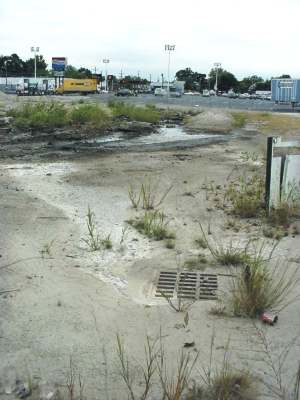|
I. Introduction (cont.)
Deed Notice Inspections Ensure Remedial Controls Remain EffectiveIn 1999, the Site Remediation Program began inspecting all sites that require environmental deed notices after completion of remedial activities to address site contamination and created a central repository for the deed notices within NJDEP. This effort includes inspections of the more than 320 sites that have engineering and institutional controls and received a no further action designation from the Department. Since the Site Remediation Program began tracking cleanup progress in the 1970s, more than 20,000 sites have received No Further Action letters without a deed notice stipulation. All sites that have received No Further Action letters with deed notices will be included for the first time in the 2000 edition of the Known Contaminated Sites in New Jersey report issued by the Department that covers each municipality in the state. As detailed in the recently revised Technical Requirements for Site Remediation and the 1998 Brownfield and Contaminated Site Remediation Act, biennial certification requirements must be met by parties required to uphold the deed notice stipulations. This requirement is necessary in order to maintain the parties covenant not to sue provision of the No Further Action letter. Property owners actually file Department approved deed notices with county and local officials as part of the remedy. A deed notice, formerly known as a Declaration of Environmental Restriction, is the institutional control that provides notification of contamination remaining on a property that exceeds the Residential Direct Contact Soil Cleanup Criteria. The deed notice details the site specific engineering and/or institutional controls that have been approved as a protective barrier between remaining contamination and residents or the environment, such as nearby streams. Some sites may require a protective cap that might consist of soil, asphalt or concrete, while others may only need fencing and restrictions on excavation. Periodic inspection and maintenance requirements ensure the continued protectiveness of the engineering and institutional controls. The Site Remediation Program will inspect each property with a deed notice on a regular schedule to ensure the approved engineering controls are properly maintained and remain protective. A report of the inspection is generated and sent to the person(s) responsible for meeting the requirements of the deed notice. The report includes a review of the information on file with NJDEP and either compliance or noncompliance with site specific requirements. Non-compliance with any requirements will result in appropriate action by NJDEP. Inspections may be more frequent based on NJDEP needs and/or a response to a complaint about a site. Furthermore, the party responsible for meeting the provisions of a deed notice must submit a certification every two years documenting site conditions to the Department. The biennial certification requires a statement that the engineering and institutional controls are being properly maintained and continue to be protective of public health and the environment. The responsible party also must verify that any engineering control was inspected and remains protective of public health and the environment.
Private Resident Helps NJDEP Uncover Deed Notice Violation in CamdenA private resident informed NJDEP that a previously installed cap was removed from a contaminated site in City of Camden and questioned if this work had been approved by the Department. The party responsible for the site received a No Further Action letter and filed a deed notice for the property that was required as part of the formal remedy approved for the site by the Department.
The responsible party notified the Site Remediation Program of the disturbance, as required, but had exceeded the time limit specified in its No Further Action letter for the site. An evaluation and inspection by NJDEP documented a breached cap with recycled concrete aggregate covering the disturbed engineering control. Runoff from the site was entering a storm drain and flowing to a tidal creek. After NJDEP notified the responsible party of the violation, the responsible party installed a temporary impermeable liner to reduce infiltration over the disturbed area and added silt fencing, filter fabric and crushed stone to control runoff. The responsible party also agreed to enter into a new Memorandum of Agreement with NJDEP outlining its future redevelopment schedule for the site. NJDEP maintains an environmental hotline for residents to call when they see or learn about a potential pollution problem. The toll-free telephone number is 1-877-WARNDEP (927-6337).
|
| To report an environmental
incident impacting NJ, call the Toll-Free 24-Hour Hotline |
||
Contact DEP | Privacy Notice | Legal Statement & Disclaimers | Accessibility Statement |
||
Site Remediation Program: SRP
Home | About SRP |
Search | Help Copyright © State of New Jersey, 1996- |

